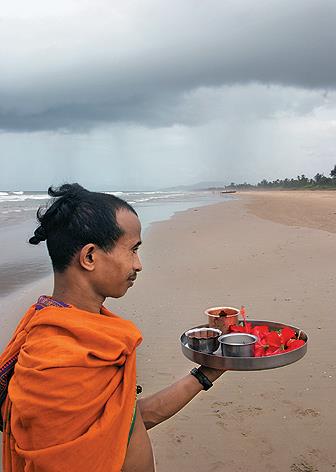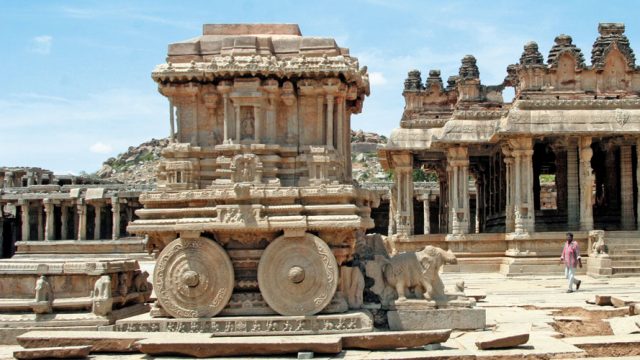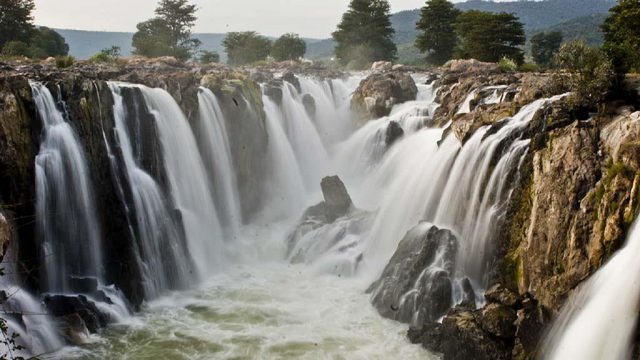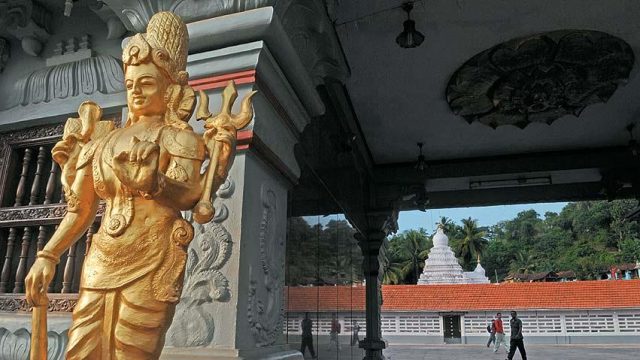The temple bells toll in the distance. “What
A couple of days ago, driving into Gokarna, the highway gradually narrowed until my car got stuck trying to enter a crowded, one-car-width road. As I inched ahead, panic-stricken, the human tide parted to make way, squeezing between my car and open gutters on either side of the road. I was afraid somebody would fall in or that another vehicle would come along. The road did slightly widen after a while. Another vehicle did drive past. Gutters continued lining the road. The swarm of people remained. Yet, we all squeezed in to fit into that road. That’s what Gokarna is all about — coexistence.
By the time I drove on, took an incredibly difficult turn into an even narrower road to my guesthouse, slipped on omnipresent cow dung, and almost fell into a gutter, I was ready to leave. I only stayed because I was too scared to drive out again. Yet, here I was, a couple of days later, seasonedly squeezing myself, walking between a car and the dreaded gutter, making way for somebody else’s arrival into Gokarna.
If Gokarna were a person, it would’ve been dubbed schizophrenic; it has two facets — a pilgrimage centre drawing hordes of devotees, and beaches attracting equal droves of flower children. The town was a bastion of orthodox Brahmins until it began attracting non-Indian visitors seeking spirituality, yoga, and virgin beaches. Today, almost half the people seen in Gokarna are foreigners.
For most visitors, their holiday begins and ends at the beaches. Most pilgrims confine themselves to the temple town. Both are neatly separated by a series of hillocks. Only one beach straddles that gap — Gokarna beach. A short walk from the temple, this is where rituals for last rites are performed; Gokarna, aka Dakshin Kashi, is considered one of India’s seven holiest ‘places of salvation’. On the very same beach, you sometimes find beach bums who’ve strayed a bit too far from neighbouring Kudle beach, a part of the ‘beach Gokarna’ side. I, in fact, was attempting to straddle the divide in my own way — I’d chosen to stay in the town and visit the beaches from there.
Very little gives away the fact that Kudle beach is located in a temple town; tourists sun-bathe, play frescobol, canoe, swim in the clean, blue waters or idle in one of the many shacks. Om beach, on the other hand, is popular with pilgrims too, attracted by its shape — an inverted Om. This lends it an air of virtuous fun, preferred by families trying to avoid the possible culture-shock at Kudle beach. Boats moored here ferry people to Paradise and Half-moon beaches, whose camps and wild parties, disallowed nowadays, make Om and Kudle beaches seem tame in comparison.
If the beaches exude a relaxed vibe, Gokarna town is their antithesis. It buzzes feverishly from as early as 4am, well into the night. All activity centres around narrow, winding ‘Car Street’; its surprisingly bohemian flavour is much like Goa in the 1970s, though it progressively wanes towards the end where Mahabaleshwara and Maha Ganapati temples become the street’s focal points. The former is dedicated to Lord Shiva, seen here in the form of an atmalinga (a piece of Shiva’s soul). The latter, to Shiva’s son Ganesh; the boy-Ganesh statue is unique, in that it is two-armed and standing.
Shops selling swimwear, spaghetti tops or bongos, strangely congruous amidst shiny brassware and devotional paraphernalia, lure you along Car Street. As you gingerly step around a painstakingly drawn rangoli outside the swimsuit shop, it reiterates why though reminiscent of Goa, Gokarna can never become Goa’s replica; the temples ensure that. Some locals do speak of resentment setting in, at their town degenerating due to immorality. In general, however, there is a nonchalant acceptance of foreign visitors — most are mindful of not hurting local sentiments and attempt to blend in. In fact, some seem more local than locals themselves.
Under the cover of darkness, Gokarna town morphs into a laidback twin of its daytime avatar. Most locals head home, while pilgrims vanish. Blackened aluminium kettles bubble away on tea-carts, supply-ing everybody’s favourite evening glassful. Sudha’s, which stocks books in a plethora of global languages, becomes a hotbed of discussion. In the multi-hued, dim lighting Gokarna seems to favour, the vagaries of that afro hairstyle, the Om tattoo, or that tongue piercing make for a people watchers’ paradise.
My last morning in Gokarna, I awoke much before the sun did, had a 5am breakfast, and didn’t find it odd; Gokarna had effortlessly sucked me into its routine. Dolphin-watching hadn’t been fruitful the evening before, so I’d decided to try again. Did I forget to mention it? Amongst all things Gokarna offers, glimpses of curious beaks, slender fins and flexible torsos are a given; if you are lucky, acrobatic breaches from the water too.
As our boat returned towards Kudle beach, we were surrounded by shoals of tiny, silver-coloured fish, jumping in sync with the boat. While photographing them, I heard the bells toll, a reminder of where I was — not on a beach holiday, but at a temple town. Ahead lay pristine Kudle beach, where shacks were just beginning to open for the day. A few early-swimmers’ heads bobbed alongside us. So wasn’t I on a beach holiday? Or, was it a temple holiday? I seemed to be constantly flitting between the two, my memories from both intertwining to form a crazy, unconventional holiday memory. I smiled as I alighted — I’d never know.
The information
Getting there
The nearest airports are Dabolim, Goa (round trip: about Rs 12,000 from Delhi) and Hubli, Karnataka (round trip: about Rs 13,000 from Delhi).
Where to stay
Swaswara resort (Rs 2,295 for five nights for two; min. five nights stay; children below 15 not allowed; 08386-257132/33; swaswara.com). Paradise Holiday Cottages (from Rs 1,000; book through online booking portals). Haripriya Residency (from Rs 1,000; 08386-257203; haripriyaresidency.com).
When to go
Gokarna experiences the monsoon from Jun to Sep, and is coolest from Nov to Feb. Dec and Jan are peak months and accommodation fills up months in advance.
heritage
hippie beaches
temples
Leave a Reply
You must be logged in to post a comment.





